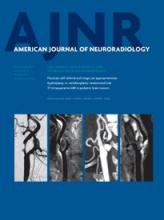Research ArticleNeurointervention
Cavernous Carotid Aneurysms in the Era of Flow Diversion: A Need to Revisit Treatment Paradigms
O. Tanweer, E. Raz, A. Brunswick, D. Zumofen, M. Shapiro, H.A. Riina, M. Fouladvand, T. Becske and P.K. Nelson
American Journal of Neuroradiology December 2014, 35 (12) 2334-2340; DOI: https://doi.org/10.3174/ajnr.A4081
O. Tanweer
aFrom the Departments of Neurosurgery (O.T., A.B., D.Z., P.K.N.)
E. Raz
bRadiology (E.R., D.Z., M.S., H.A.R., T.B., P.K.N.)
A. Brunswick
aFrom the Departments of Neurosurgery (O.T., A.B., D.Z., P.K.N.)
D. Zumofen
aFrom the Departments of Neurosurgery (O.T., A.B., D.Z., P.K.N.)
bRadiology (E.R., D.Z., M.S., H.A.R., T.B., P.K.N.)
M. Shapiro
bRadiology (E.R., D.Z., M.S., H.A.R., T.B., P.K.N.)
H.A. Riina
bRadiology (E.R., D.Z., M.S., H.A.R., T.B., P.K.N.)
M. Fouladvand
cNeurology (M.F., T.B., P.K.N.), New York University School of Medicine, New York, New York.
T. Becske
bRadiology (E.R., D.Z., M.S., H.A.R., T.B., P.K.N.)
cNeurology (M.F., T.B., P.K.N.), New York University School of Medicine, New York, New York.
P.K. Nelson
aFrom the Departments of Neurosurgery (O.T., A.B., D.Z., P.K.N.)
bRadiology (E.R., D.Z., M.S., H.A.R., T.B., P.K.N.)
cNeurology (M.F., T.B., P.K.N.), New York University School of Medicine, New York, New York.

References
- 1.↵
- Eddleman CS,
- Hurley MC,
- Bendok BR, et al
- 2.↵
- 3.↵
- Stiebel-Kalish H,
- Kalish Y,
- Bar-On RH, et al
- 4.↵
- Wiebers D
- 5.↵
- Lylyk P,
- Miranda C,
- Ceratto R, et al
- 6.↵
- Nelson PK,
- Lylyk P,
- Szikora I, et al
- 7.↵
- Becske T,
- Kallmes DF,
- Saatci I, et al
- 8.↵
- O'Kelly CJ,
- Spears J,
- Chow M, et al
- 9.↵
- Shapiro M,
- Becske T,
- Riina HA, et al
- 10.↵
- Lee AG,
- Mawad ME,
- Baskin DS
- 11.↵
- Goldenberg-Cohen N
- 12.↵
- 13.↵
- Dolenc VV
- 14.↵
- Heros RC
- 15.↵
- Heros RC,
- Nelson PB,
- Ojemann RG, et al
- 16.↵
- Jafar JJ,
- Huang PP
- 17.↵
- Swearingen B,
- Heros RC
- 18.↵
- Drake CG,
- Peerless SJ,
- Ferguson GG
- 19.↵
- 20.↵
- Parkinson RJ,
- Eddleman CS,
- Batjer HH, et al
- 21.↵
- Ponce FA,
- Albuquerque FC,
- McDougall CG, et al
- 22.↵
- van der Schaaf IC,
- Brilstra EH,
- Buskens E, et al
- 23.↵
- Yonas H,
- Kaufmann A
- 24.↵
- van Rooij WJ
- 25.↵
- Arambepola PK,
- McEvoy SD,
- Bulsara KR
- 26.↵
- Brinjikji W,
- Murad MH,
- Lanzino G, et al
- 27.↵
- Yu SC,
- Kwok CK,
- Cheng PW, et al
- 28.↵
- van Rooij WJ,
- Sluzewski M,
- Beute GN
- 29.
- Berge J,
- Biondi A,
- Machi P, et al
- 30.
- Chan TT,
- Chan KY,
- Pang PK, et al
- 31.
- Chitale R,
- Gonzalez LF,
- Randazzo C, et al
- 32.
- Çinar C,
- Bozkaya H,
- Oran I
- 33.
- Fischer S,
- Vajda Z,
- Aguilar Perez M, et al
- 34.
- Lubicz B,
- Collignon L,
- Raphaeli G, et al
- 35.
- McAuliffe W,
- Wycoco V,
- Rice H, et al
- 36.
- Piano M,
- Valvassori L,
- Quilici L, et al
- 37.
- Saatci I,
- Yavuz K,
- Ozer C, et al
- 38.
- Velioglu M,
- Kizilkilic O,
- Selcuk H, et al
In this issue
American Journal of Neuroradiology
Vol. 35, Issue 12
1 Dec 2014
Advertisement
O. Tanweer, E. Raz, A. Brunswick, D. Zumofen, M. Shapiro, H.A. Riina, M. Fouladvand, T. Becske, P.K. Nelson
Cavernous Carotid Aneurysms in the Era of Flow Diversion: A Need to Revisit Treatment Paradigms
American Journal of Neuroradiology Dec 2014, 35 (12) 2334-2340; DOI: 10.3174/ajnr.A4081
0 Responses
Jump to section
Related Articles
- No related articles found.
Cited By...
- Reconstruction of the sphenoid sinus erosion or dehiscence after treatment of unruptured intracavernous aneurysms with flow diverter stents
- Flow diversion for compressive unruptured internal carotid artery aneurysms with neuro-ophthalmological symptoms: a systematic review and meta-analysis
- Onset-to-treatment time and aneurysmal regression predict improvement of cranial neuropathy after flow diversion treatment in patients with symptomatic internal carotid artery aneurysms
- Long-term outcomes of flow diversion for unruptured intracranial aneurysms: a systematic review and meta-analysis
- Onset-to-treatment time and aneurysmal regression predict improvement of cranial neuropathy after flow diversion treatment in patients with symptomatic internal carotid artery aneurysms
- Flow diversion for compressive unruptured internal carotid artery aneurysms with neuro-ophthalmological symptoms: a systematic review and meta-analysis
- Flow diversion for internal carotid artery aneurysms with compressive neuro-ophthalmologic symptoms: clinical and anatomical results in an international multicenter study
- Use of flow diverter stent for treatment of a cervical carotid artery dissection and pseudoaneurysm causing Horners syndrome
- Flow Diversion in Ruptured Intracranial Aneurysms: A Meta-Analysis
- Carotid cavernous fistula after Pipeline placement: a single-center experience and review of the literature
- Treatment of direct carotid-cavernous fistulas with a double lumen balloon
- Therapeutic Internal Carotid Artery Occlusion for Large and Giant Aneurysms: A Single Center Cohort of 146 Patients
This article has not yet been cited by articles in journals that are participating in Crossref Cited-by Linking.
More in this TOC Section
Similar Articles
Advertisement











